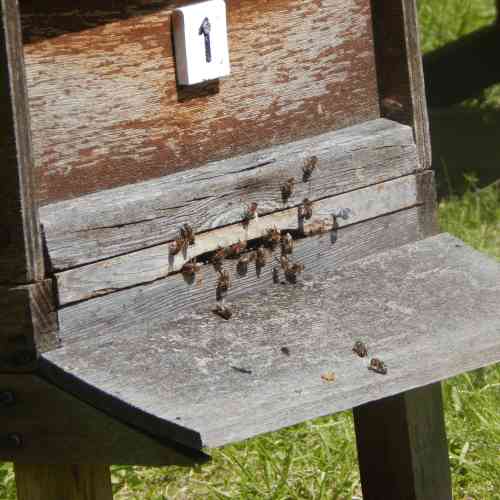Robber Bees
Updated: 29th January 2021
You may have heard of 'robber bees', and beekeepers may see them around a hive. What this amounts to, is honey bees from a colony in one hive entering the hive of another colony, in order to rob it of its resources - i.e. the honey stores.
Robbing behavior can seriously weaken the target colony. However, those bees that engage in robbing may risk their lives to steal the other colony's honey if a hive is occupied. They must first overcome the guard bees, or any other members of the colony that may seek to defend the stores.
If there are no bees to defend the target colony, due for example, to death of the colony, then the robber bees expose themselves to a different risk - i.e. catching the deadly disease or parasite, and transporting it back to their own colonies.
But why do honey bees do this type of behavior?
Robber bees - why honey bees steal from other colonies

1. An efficient means to gather food
Firstly, it should be mentioned that, as Thomas D. Seeley in The Lives Of Bees, there is a good incentive for honey bees to rob ready made honey from other colonies, because it is a very efficient way to transport high energy food back to their own hive or nest.
Nectar gathered from flowers contains about 40% sugar, whereas honey contains about 80% sugar, meaning that a honey bee's crop filled with honey will provide twice as much energy for the developing colony as a crop full of nectar.
2. A dearth of nectar - poor nectar flow
Robbing occurs when there is insufficient nectar for the colony to gather for its health and survival. This could happen, for example, due to the impact of weather on flowering seasons and nectar flow.
The risk of nectar robbing is another reason why beekeepers are advised to assess the availability of appropriate floral resource in a location, prior to setting up a hive, as well as perhaps finding out about other hives in the area.
It also reinforces the need for beekeepers themselves to actively include as many nectar and pollen rich plants, shrubs and trees in their own gardens.
3. Too much honey is removed from the hive
It may also occur if beekeepers do not leave sufficient honey in a hive for the survival of the colony, requiring the bees to seek elsewhere for food.
How the robber bees harvest the honey when robbing
Primarily, the robber bees will enter a nest or hive and will first target honeycomb cells that are already open, so that the honey can be removed more quickly and efficiently.
If the cells have already been capped with a layer of wax, the robber bee will use her mandibles (jaws) to create a small hole large enough to insert her tongue (proboscis), so that she can suck up the nectar.
Other bees may join her at the 'feeding hole' thus enlarging it.
Risks of robbing behavior
One of the primary concerns about robbing behavior is the potential to transfer diseases and parasites from one colony to another. For example, this is a means by which Varroa mite could be transferred from one colony to another.
Other diseases, such as American foulbrood and chalkbrood could also find their way into previously uninfected colonies.
Robbing also poses a threat to the target colony in that it may be severely weakened as a result of being robbed of its stores.
How can beekeepers prevent robbing behavior?
The following steps will help prevent robbing behaviors:
- Ensure bees have sufficient stocks of their honey in the hive to get them through times when there are fewer flowers in bloom. This can help to discourage them from looking elsewhere, and keep colonies strong and fit.
- Remove dead and diseased colonies as soon as possible. Dead colonies can leave behind food stores that may be attractive to robbers. However, this is a means by which diseases can spread.
- Feeding sugar syrup to bees can encourage robbing behavior from wasps, as well as other bees, therefore, it is better to leave sufficient honey stores for the colony.
The smell of sugar syrup during poor nectar flow, can encourage robbing behavior from nearby colonies if placed in the hive.
If, however, it is necessary to feed sugar syrup or honey to help compensate for the lack of available nectar, then in such circumstances, 'station feeding' outside of the hive away from the entrance, would be a better option.
An appropriate feeder can be filled with sugar syrup and placed in a location outside of the hive, and away from the entrance, for bees to gather it and return it to their colonies. - Reducing the size of the hive entrance can also help to make it easier for guard bees to defend the colony. If robber bees are entering the hive, the hive could temporarily be covered over with a wet sheet.
Does robbing behavior occur in wild honey bee colonies?
Indeed it does, according to observations and studies conducted by Thomas Seeley and then PhD student, David Peck in the Arnot Forest, USA, robbing behavior is practiced by wild colonies too.
Seeley proposes that this is one way in which parasites such as Varroa could be spread among wild colonies.